Welp, with some desoldering, cutting, soldering, and more cutting, I now have an actual UNROM cartridge!  It has pretty much the same functionality as the
jungle of wires version, though it'll still need a switch added in to toggle between horizontal and vertical mirroring (I won't get into explaining that this time).¬ For now, it uses vertical mirroring, which is fine, because that's what Contra uses, which was already on my eeprom.
For the sacrificial cartridge, I used Silent Service.¬ Not the worst game ever, but not the best one either.¬ Plus, I got it for 99 cents, so there you go.¬ Getting it open was kind of a pain in the ass, because Nintendo cartridges used those stupid security screws, and I don't have the screwdriver for it.¬ But, I took a tiny jeweler's type screwdriver, along with a really stiff piece of wire, and was able to force at the notches from both sides of the screw to get it to turn, and after a minute or two of this, you can get'em out.¬ Once you get the hang of it, they come out fairly well.¬ There's three in a cart.
Once it's open, this is what you end up with*:
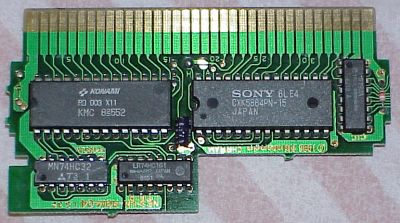 * I forgot to take a picture before I modified it.  ^_^;  But this is almost identical.  Mine just had a capacitor on both ends, and used different model chips.
* I forgot to take a picture before I modified it.  ^_^;  But this is almost identical.  Mine just had a capacitor on both ends, and used different model chips.I should have also taken a picture of it after I removed the PRG rom (the one on the left in that picture), but oh well. But anyhow, some rewiring was in order. The PRG rom was just 28 pins, and my eeprom is 32 pins. Even a 28 pin eeprom would have taken some rewiring, but in my case, I needed to fit a socket which was even larger than the board was designed to handle. I actually started out with a 40-pin socket, which is all I had handy aside from a 28-pin one, so I had to cut it down to just 32 pins. But after carefully planning out last night which pins needed to be bypassed and which needed to be reconnected elsewhere, I was able to get the socket soldered in place. It was just the wires that were the hard part! The only hook-up wire I have is 22 guage, which is thick and stiff. I needed something thinner and flexible, so I used some wires pulled off an old floppy cable (the rest of which is what was used in my breadboard version).
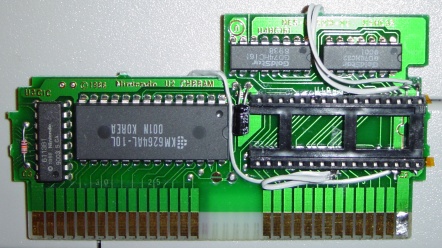
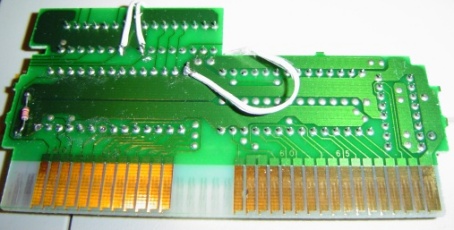
You might notice the one cartridge pin is silver.¬ That's because I originally tried to use that for ground connections since it was closest, but it was wasn't going to work very well.¬ That wasn't the only thing that had to get rewired, though, because I realized it wasn't even going to fit back in the cartridge casing, so I had to redo another wire as well.¬ Also, I should have taken a picture beforehand so you could see, but the capacitor on that side of the board was just plain in the way.¬ It was right under where the end of the socket needed to lay.¬ So, I desoldered it, and put it back on from the back side of the board, as you can see on the left side of the second picture there.¬ I also took advantage of the +5v going into the one end of that same¬ capacitor, and used that for the top right pin of the eeprom for power, and also to hold the write line high since that pin was right below it.¬ I just bent the latter straight over on top of the power one and added a tiny dab more solder.
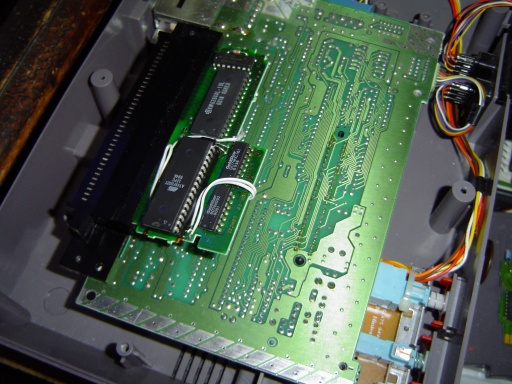
There it is in the NES with the eeprom inserted into the socket.¬ My surprise was the board actually working on the very first try.¬ I seem to generally have bad luck with electronics projects, despite my interest in them.¬ But it went really smoothly, and works like a charm.¬ I don't even get the sprite glitches like I'd get sometimes on my breadboard jungle version.
But now I wanted it back in the case.¬ The eeprom in the socket is simply too tall to fit back inside properly.¬ But that's nothing that an
hour with my piece of shit dremel couldn't fix.
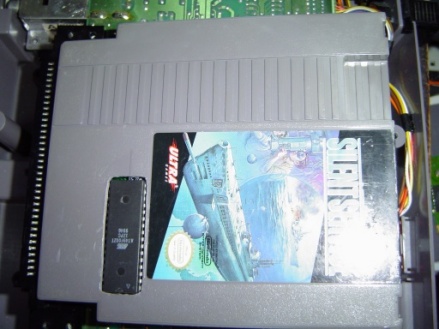
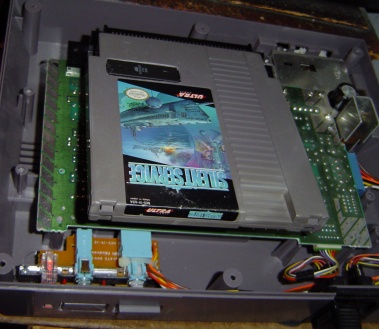
I replaced the security screws with a couple I found elsewhere.¬ It was hard finding some small enough to fit.¬ But there you go, a working UNROM development cart, running Contra at the moment.¬ You might even notice that the cartridge tray isn't in that NES, and nothing is pushing the cart down like you're normally supposed to.¬ That's because my refurbishing of the pin connector has it making such a good connection that even when the cartridge tray is in the system, you don't even have to push it down.¬ It's pretty strange to see that for the first time when you turn on an NES with the cart sticking up like that, and have it work just fine.¬ I didn't do that part today, though.¬ That was to get SMB/Duck Hunt working before, since I'm still forever playing those.¬ xD
There's a couple things or so on the todo list for this project.¬ First is adding in the switch to toggle between horizontal and vertical mirroring modes, since a game won't work properly unless it's set to which it was designed for.¬ The other thing I'd like to add is a toggle switch to switch between the upper and lower 128kb of the eeprom (since it's a 256kb chip).¬ The cart is just using 128kb at any particular time for the game, so it's capable of storing two games, just like my jungle board did.¬ On that, I just switched a wire from ground to +5v to switch between games, and a similar method for setting the mirroring.¬ The cartridge here though will take a bit more work.¬ And possibly a glue gun to put the switches in place, which I don't think we have!
I could also modify the board to run actual 256kb UNROM games, but there really weren't all that many of those, so I might not bother.¬ Final Fantasy 2 and Paperboy 2 are the only ones worth mentioning, prolly.
THAS' AWL.